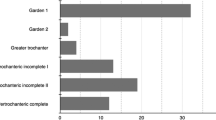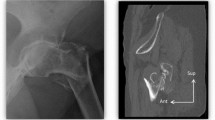Abstract
Purpose
To determine the margins of non-inferiority of the sensitivity of CT and the sample size needed to test the non-inferiority of CT in comparison with MRI.
Materials and methods
During a 2-year period, elderly patients with suspected radiographically occult post-traumatic bone injuries were investigated by CT and MRI in two institutions. Four radiologists analyzed separately the CT and MRI examinations to detect post-traumatic femoral injuries. Their sensitivities at CT (SeCT) and MRI (SeMRI) were calculated with the reference being a best valuable comparator (consensus reading of the MRI and clinical follow-up). ROC analysis followed by an exact test (Newcombe’s approach) was performed to assess the 95% confidence interval (CI) for the difference SeCT–SeMRI for each reader. A sample size calculation was performed based on our observed results by using a one-sided McNemar’s test.
Results
Twenty-nine out of 102 study participants had a post-traumatic femoral injury. SeCT ranged between 83 and 93% and SeMRI ranged between 97 and 100%. The 95% CIs for (SeCT–SeMRI) were [− 5.3%, + 0.8%], (pR1 = 0.1250), [− 4.5%; + 1.2%] (pR2 = 0.2188), [− 3.4%; + 1.1%] (pR3 = 0.2500) to [− 3.8%; + 1.6%] (pR4 = 0.3750) according to readers, with a lowest limit for 95% CIs superior to a non-inferiority margin of (− 6%) for all readers. A population of 440 patients should be analyzed to test the non-inferiority of CT in comparison with MRI.
Conclusion
CT and MRI are sensitive for the detection of radiographically occult femoral fractures in elderly patients after low-energy trauma. The choice between both these modalities is a compromise between the most available and the most sensitive technique.
Key Points
• The sensitivity of four separate readers to detect radiographically occult post-traumatic femoral injuries in elderly patients after low-energy trauma ranged between 83 and 93% at CT and between 97 and 100% at MRI according to a best valuable comparator including MRI and clinical follow-up.
• CT is a valuable alternative method to MRI for the detection of post-traumatic femoral injuries in elderlies after low-energy trauma if a 6% loss in sensitivity can be accepted in comparison with MRI.
• The choice between CT and MRI is a compromise between the most available and the most sensitive technique.






Similar content being viewed by others
Abbreviations
- AUC:
-
Area under the curve
- CI:
-
Confidence interval
- CT:
-
Computed tomography
- MRI:
-
Magnetic resonance imaging
- NPV:
-
Negative predictive value
- PACS:
-
Picture archiving and communication systems
- PPV:
-
Positive predictive value
- ROC:
-
Receiver operating characteristic
- SD:
-
Standard deviation
- Se:
-
Sensitivity
- SE:
-
Spin echo
- Sp:
-
Specificity
- STIR:
-
Short tau inversion recovery
References
Gullberg B, Johnell O, Kanis JA (1997) World-wide projections for hip fracture. Osteoporos Int 7:407–413
Ensrud KE (2013) Epidemiology of fracture risk with advancing age. J Gerontol A Biol Sci Med Sci 68:1236–1242
Cooper C, Campion G, Melton LJ 3rd (1992) Hip fractures in the elderly: a world-wide projection. Osteoporos Int 2:285–289
Zuckerman JD, Skovron ML, Koval KJ, Aharonoff G, Frankel VH (1995) Postoperative complications and mortality associated with operative delay in older patients who have a fracture of the hip. J Bone Joint Surg Am 77:1551–1556
Ward RJ, Weissman BN, Kransdorf MJ et al (2014) ACR appropriateness criteria acute hip pain-suspected fracture. J Am Coll Radiol 11:114–120
Parker MJ (1992) Missed hip fractures. Arch Emerg Med 9:23–27
Khan SK, Kalra S, Khanna A, Thiruvengada MM, Parker MJ (2009) Timing of surgery for hip fractures: a systematic review of 52 published studies involving 291,413 patients. Injury 40:692–697
Deutsch AL, Mink JH, Waxman AD (1989) Occult fractures of the proximal femur: MR imaging. Radiology 170:113–116
Rizzo PF, Gould ES, Lyden JP, Asnis SE (1993) Diagnosis of occult fractures about the hip. Magnetic resonance imaging compared with bone-scanning. J Bone Joint Surg Am 75:395–401
Bogost GA, Lizerbram EK, Crues JV 3rd (1995) MR imaging in evaluation of suspected hip fracture: frequency of unsuspected bone and soft-tissue injury. Radiology 197:263–267
Lubovsky O, Liebergall M, Mattan Y, Weil Y, Mosheiff R (2005) Early diagnosis of occult hip fractures MRI versus CT scan. Injury 36:788–792
Dominguez S, Liu P, Roberts C, Mandell M, Richman PB (2005) Prevalence of traumatic hip and pelvic fractures in patients with suspected hip fracture and negative initial standard radiographs--a study of emergency department patients. Acad Emerg Med 12:366–369
Cabarrus MC, Ambekar A, Lu Y, Link TM (2008) MRI and CT of insufficiency fractures of the pelvis and the proximal femur. AJR Am J Roentgenol 191:995–1001
Hakkarinen DK, Banh KV, Hendey GW (2012) Magnetic resonance imaging identifies occult hip fractures missed by 64-slice computed tomography. J Emerg Med 43:303–307
Jordan R, Dickenson E, Westacott D, Baraza N, Srinivasan K (2013) A vast increase in the use of CT scans for investigating occult hip fractures. Eur J Radiol 82:e356–e359
Heikal S, Riou P, Jones L (2014) The use of computed tomography in identifying radiologically occult hip fractures in the elderly. Ann R Coll Surg Engl 96:234–237
Haubro M, Stougaard C, Torfing T, Overgaard S (2015) Sensitivity and specificity of CT- and MRI-scanning in evaluation of occult fracture of the proximal femur. Injury 46:1557–1561
Rehman H, Clement RG, Perks F, White TO (2016) Imaging of occult hip fractures: CT or MRI? Injury 47:1297–1301
Sadozai Z, Davies R, Warner J (2016) The sensitivity of ct scans in diagnosing occult femoral neck fractures. Injury 47:2769–2771
Thomas RW, Williams HL, Carpenter EC, Lyons K (2016) The validity of investigating occult hip fractures using multidetector CT. Br J Radiol 89:20150250
Dunker D, Collin D, Göthlin JH, Geijer M (2012) High clinical utility of computed tomography compared to radiography in elderly patients with occult hip fracture after low-energy trauma. Emerg Radiol 19:135–139
National Clinical Guideline Centre (UK) (2011) The management of hip fracture in adults. NICEClinical Guidelines, No. 124
Collin D, Geijer M, Göthlin JH (2016) Computed tomography compared to magnetic resonance imaging in occult or suspect hip fractures. A retrospective study in 44 patients. Eur Radiol 26:3932–3938
Kellock TT, Nicolaou S, Kim SSY et al (2017) Detection of bone marrow edema in nondisplaced hip fractures: utility of a virtual noncalcium dual-energy CT application. Radiology 284:922
Buderer NM (1996) Statistical methodology: I. incorporating the prevalence of disease into the sample size calculation for sensitivity and specificity. Acad Emerg Med 3:895–900
Newcombe RG (1998) Improved confidence intervals for the difference between binomial proportions based on paired data. Stat Med 17:2635–2650
Alam A, Willett K, Ostlere S (2005) The MRI diagnosis and management of incomplete intertrochanteric fractures of the femur. J Bone Joint Surg Br 87:1253–1255
Chana R, Noorani A, Ashwood N, Chatterji U, Healy J, Baird P (2006) The role of MRI in the diagnosis of proximal femoral fractures in the elderly. Injury 37:185–189
Frihagen F, Nordsletten L, Tariq R, Madsen JE (2005) MRI diagnosis of occult hip fractures. Acta Orthop 76:524–530
Pejic A, Hansson S, Rogmark C (2017) Magnetic resonance imaging for verifying hip fracture diagnosis why, when and how? Injury 48:687–691
Ahn S, Park SH, Lee KH (2013) How to demonstrate similarity by using noninferiority and equivalence statistical testing in radiology research. Radiology 267:328–338
Haramati N, Staron RB, Barax C, Feldman F (1994) Magnetic resonance imaging of occult fractures of the proximal femur. Skeletal Radiol 23:19–22
Oka M, Monu JU (2004) Prevalence and patterns of occult hip fractures and mimics revealed by MRI. AJR Am J Roentgenol 182:283–288
Pandey R, McNally E, Ali A, Bulstrode C (1998) The role of MRI in the diagnosis of occult hip fractures. Injury 29:61–63
Quinn SF, McCarthy JL (1993) Prospective evaluation of patients with suspected hip fracture and indeterminate radiographs: use of T1-weighted MR images. Radiology 187:469–471
Kirby MW, Spritzer C (2010) Radiographic detection of hip and pelvic fractures in the emergency department. AJR Am J Roentgenol 194:1054–1060
Geijer M, Dunker D, Collin D, Göthlin JH (2012) Bone bruise, lipohemarthrosis, and joint effusion in CT of non-displaced hip fracture. Acta Radiol 53:197–202
Reddy T, McLaughlin PD, Mallinson PI et al (2015) Detection of occult, undisplaced hip fractures with a dual-energy CT algorithm targeted to detection of bone marrow edema. Emerg Radiol 22:25–29
Pathria MN, Chung CB, Resnick DL (2016) Acute and stress-related injuries of bone and cartilage: pertinent anatomy, basic biomechanics, and imaging perspective. Radiology 280:21–38
Chang EY, Bae WC, Shao H et al (2015) Ultrashort echo time magnetization transfer (UTE-MT) imaging of cortical bone. NMR Biomed 28:873–880
Jerban S, Ma Y, Nazaran A et al (2018) Detecting stress injury (fatigue fracture) in fibular cortical bone using quantitative ultrashort echo time-magnetization transfer (UTE-MT): an ex vivo study. NMR Biomed 31:e3994
Collin D, Dunker D, Göthlin JH, Geijer M (2011) Observer variation for radiography, computed tomography, and magnetic resonance imaging of occult hip fractures. Acta Radiol 52:871–874
Karch A, Koch A, Zapf A, Zerr I, Karch A (2016) Partial verification bias and incorporation bias affected accuracy estimates of diagnostic studies for biomarkers that were part of an existing composite gold standard. J Clin Epidemiol 78:73–82
Funding
The authors state that this work has not received any funding.
Author information
Authors and Affiliations
Corresponding author
Ethics declarations
Guarantor
The scientific guarantor of this publication is B. Vande Berg.
Conflict of interest
The authors of this manuscript declare no relationships with any companies whose products or services may be related to the subject matter of the article.
Statistics and biometry
One of the authors (N Michoux) has significant statistical expertise.
Informed consent
Written informed consent was obtained from all subjects (patients) in this study.
Ethical approval
Institutional Review Board approval was obtained from the two participating institutions.
Methodology
• Prospective
• Diagnostic or prognostic study
• Multicenter study
Additional information
Publisher’s note
Springer Nature remains neutral with regard to jurisdictional claims in published maps and institutional affiliations.
Rights and permissions
About this article
Cite this article
Lanotte, S.J., Larbi, A., Michoux, N. et al. Value of CT to detect radiographically occult injuries of the proximal femur in elderly patients after low-energy trauma: determination of non-inferiority margins of CT in comparison with MRI. Eur Radiol 30, 1113–1126 (2020). https://doi.org/10.1007/s00330-019-06387-2
Received:
Revised:
Accepted:
Published:
Issue Date:
DOI: https://doi.org/10.1007/s00330-019-06387-2




